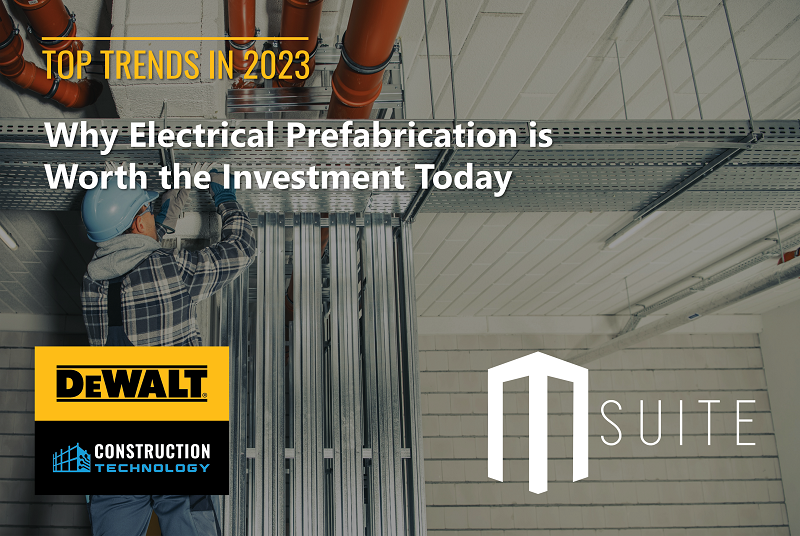Have you tried electrical prefabrication on a recent project?
Like many other construction industry sectors, electrical prefabrication is becoming more popular in the electrical industry for many reasons, including, but not limited to, improved productivity, reduced costs, and increased component installation times. As a result, modular construction is also leveraging these methods successfully.
Prefabrication includes identifying repeatable field installation tasks that can be built ahead of time and offsite. It’s a versatile construction method that provides many more benefits than traditional construction methods.
In a McGraw-Hill report highlighting “Prefab and Modularization and its impact on increasing productivity,” the benefits of using model-based prefabrication are striking, with an average of 90% of users reporting improved quality, increased schedule certainty, and productivity compared to traditional stick-built methods. In addition, at least 80% of users reported reduced waste, increased customer satisfaction, and improved cost predictability.
This article highlights why prefabrication and modular methods offer considerable efficiencies and savings for electrical contractors.
Prefabrication Offers Cost Savings
If performed correctly, prefabrication advocates, trades, and owners have touted substantial cost savings on projects in the following areas:
- Reducing material costs: Prefabrication can dramatically reduce material cost by both allowing you to identify areas to minimize waste while also allowing many contractors to re-use scrap material that was previously just thrown out.
- Buying materials in bulk: The repetition of projects can help you save money on purchasing standard materials in bulk used for assemblies and components.
- Reducing waste: Prefabrication is bringing cost savings and helping achieve green building goals. The repeat prefabrication of materials enables you to maximize efficiency.
- Reduce labor costs on projects: Prefabrication helps to reduce labor costs by preparing components in secure facilities and prepping them for field installs, reducing rework and errors on the jobsite. In many cases, contractors can purchase prefabricated components from their suppliers, reducing the number of staff on the jobsite.
- Improve safety in the field: This brings labor cost savings by making things safer for field workers.
- Reduce estimating costs: Another cost saving is achieved through electrical estimating, adding prefabricated assemblies to your system, and speeding up your counting process even further.
Prefabrication offers Time Savings
- Time savings is a significant benefit prefabrication offers electrical contractors. Using prefabricated assemblies helps contractors streamline their quality assurance and installation processes, greatly reducing labor time on the jobsite.
- Prefabricated assemblies require setup to exact specifications, quality testing, and no adjustments on-premises. The best examples only need electrical connections to work and eliminate other ancillary delays, such as retrieving forgotten tools or materials.
- Prefab also optimizes material handling on jobsites with greater precision of materials being delivered in the specific space for install or easily transferred to the room instead of materials being moved multiple times which is common among traditional construction methods. Through repetition, teams become proficient at installing prefabricated assemblies and operationally gain improvement with each project.
- Electrical contractors receiving plans early during pre-construction can shorten project timelines by utilizing prefabrication on components before the building is built or renovated, reducing the overall project timeline. Prefabricating can even help reduce the timeframe by minimizing weather impacts on construction. For example, something prefabricated in a fabrication shop can avoid weather delays if the components require configuration and installation on the jobsite.
Using Electrical Prefabrication Effectively
Prefabrication and modularization require experience and skill therefore experts recommend starting small before going big. For example, try prefabricating temporary lighting, bending conduits, or wiring devices on your first attempt. The reason this recommendation works is because it helps companies figure out what works and what doesn’t with limited risk to a project.
Electrical contractors should speak with experts and examine current staffing, tools, and facilities before rolling out larger, more complex prefab work in-house. Considerations include training, planning prefab activities, establishing scalable prefab shop space, and ensuring that the shop has the right equipment, tools, and software.
Additionally, it’s critical to understand that prefabrication is an outcome of sound project planning and execution. It will fail or succeed based on the project plan’s quality and the information at the start. While prefabricated components don’t need to be limited to only small items, larger prefab projects require experience and expertise. Any incorrect or incomplete specs or drawings, among other issues, could be consequential to your project.
Electrical Prefabrication’s Future
Electrical prefabrication is making successful progress and improved collaboration with other trade contractors on projects is evidence for its assent. Major firms are already integrating prefabricated electrical components such as lighting packages and panel builds into modular data center skids made by construction firms. In addition, green building initiatives are driving construction firms to improve waste management.
One report indicates that automation software can reduce construction waste to help increase workflows and reduce inefficiencies. Additionally, we should continue to see incentives for firms to turn to prefabrication as environmental and waste management laws and rules tighten.
As electrical contractors seek to increase efficiency and reduce costs, prefabrication is quickly becoming a must do to stay competitive.
Electrical Prefabrication Software Designed for the Fabrication Shop
Is investing in prefabrication worth it for electrical trade contractors? Overall, it represents dramatic savings in terms of costs and time, but the caveat is that you need experience, skill, and exceptional planning, not to mention willingness to try something new.
Where plans are continually changing or incomplete, as with any construction method, prefabrication can create headaches. However, strengthening your planning processes and knowledge can bring substantial results using prefabrication.
Ensuring that your team is properly trained, knowledgeable, and has the right tools for prefabrication is a prerequisite. Remember to start small is also a wise strategy to test, evaluate and expand.







